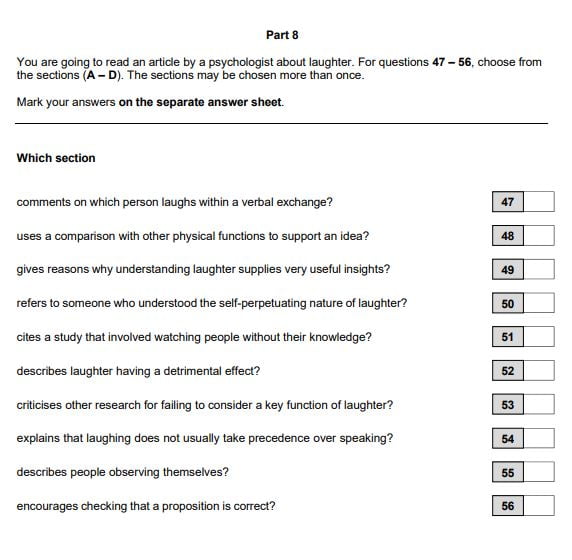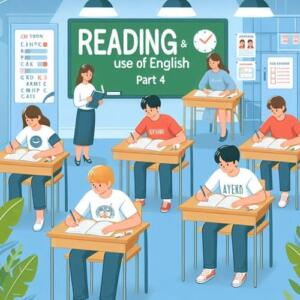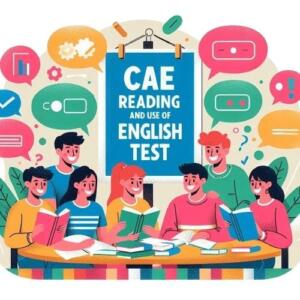CAE Reading and Use of English (RUE) Part 8
How to ace CAE reading part 8 - Your free step-by-step guide.
What you will find in this guide:
Introduction
Though CAE (Certificate in Advanced English) has a new name now and is called “Cambridge C1 Advanced”, I still prefer to call it the CAE, and this free step by step guide is all about acing this test. So, if you are preparing for the Cambridge CAE exam, this free guide is for you. The CAE reading part 8 is the last and most difficult part of the Reading and Use of English paper. You have to read a long text and answer 10 questions about it. In this blog post, I will explain the structure of part 8, the challenging factors, some common mistakes, and will give you a completely free step by step guide as well as some important tips to ace this part. If you wish you to read about other parts of the Cambridge C1 Advanced (CAE), you can read my other guides by clicking here, and to read my guides to part 7 click here.
The Reading Task
According to Cambridge, the CAE Reading Part 8, also known as the Multiple Matching task, is a type of exercise that tests your reading comprehension and ability to identify relevant information from a text. In this task, you will see 10 questions about four paragraphs presented after the questions. Your goal is to match each question with the correct paragraph based on the information from the text. You will need to pay attention to the wording of the questions and the text, as they may use different words to express the same idea. You will also need to manage your time well, as the number of questions in this part is high.
What You Are Expected to Do:
- You are required to match the questions with the relevant information from the text1.
- This involves reading and understanding both the questions and the text1.
- You need to be able to recognize paraphrasing, as the answers are often not directly stated in the text but are paraphrased1.
- Efficient time management is crucial. You are recommended to quickly skim through all the texts for an overall impression, then read the questions and scan for the answers1.

Challenging Factors
The CAE Reading Part 8, can be challenging because it requires you to read a long and complex text and choose the best option among similar ones. You have to work fast and pay attention to the small differences between the options. You might also encounter some words, phrases or expressions that you are not familiar with and that might make you confused. To succeed in this part, you need to have a good plan and some practice. A paramount factor in preparing for this part relates to expecting the difficulties and preparing for them. So please take the following challenges into consideration:
Volume of Text: This part consists of a set of questions followed by one page of text1. The amount of text to read and comprehend within the time limit can be daunting2.
- Text Complexity: It is often the case that that the text is written using complex language, academic words, and unfamiliar concepts. Some candidates may find this complexity of ideas and words challenging to understand and have difficulty following through with the text.
- Similarity of the ideas: The extracts can look very similar. This can add to the difficulty of this task because candidates often get confused when they get questions about similar ideas.
Multiple Matching: There are 10 questions and four to six options1. Candidates are required to match the questions with the relevant information from the text1. This requires careful reading and understanding of both the questions and the text.
Paraphrasing: The answers are often not directly stated in the text but are paraphrased2. Recognizing paraphrase plays an important part in finding the answers2.
Time Management: Efficient time management is crucial. It’s recommended to quickly skim through all the texts for an overall impression, then read the questions and scan for the answers23.
Uncertainty: Candidates are often unsure about their answers. If you have been in this situations, know that you are not alone. Many people feel the same and are unsure about an answer.
Remember, practice is key to overcoming these challenges in CAE reading part 8. Regularly practicing under exam conditions can help improve speed, comprehension, and accuracy3.
Common Mistakes in CAE Reading Part 8
Because the CAE reading part 8 is quite a challenging task, and you need to read a long text, some candidates make mistakes that lower their score in this part. To avoid these errors, you need to be aware of them and practice how to overcome them. Here are some of the most common mistakes that candidates make in the CAE Reading Part 8:
Lack of Strategy: Candidates often struggle because they are not really sure what to do1. Good strategy can make a significant difference1.
- Spending too much time on one question: It is often the case that candidates encounter a questions they can’t find an answer to, and they spend too much time thinking about it, essentially ignoring other questions and wasting their time on something they can’t solve. In this case, you have to skip the difficult question and go to other questions because leaving one question unanswered is better than leaving many!
Question by Question Approach: One of the biggest mistakes is that candidates try to complete the task question by question. This means they look at the first prompt and go through the whole text until they find the part that corresponds with the question, then repeat the same process with all the other questions1.
Not Practicing Skimming and Scanning: Candidates often read every word in the text, which is time-consuming and inefficient2. Practicing skimming and scanning texts to prepare for the multiple-matching task can be very helpful2.
Not Understanding Paraphrasing: The exact words from the questions or prompts won’t be in the text, but rather it’ll be paraphrased3. So, candidates need to look for similar meanings expressed with different vocabulary3.
CAE Reading Part 8, Sample Question
CAE Reading Part 8
You are going to read an article by a psychologist about laughter. For questions 47 – 56, choose from the sections (A – D). The sections may be chosen more than once.
Mark your answers on the separate answer sheet.
Which section
comments on which person laughs within a verbal exchange?
uses a comparison with other physical functions to support an idea?
gives reasons why understanding laughter supplies very useful insights?
refers to someone who understood the self-perpetuating nature of laughter?
cites a study that involved watching people without their knowledge?
describes laughter having a detrimental effect?
criticises other research for failing to consider a key function of laughter?
explains that laughing does not usually take precedence over speaking?
describes people observing themselves?
encourages checking that a proposition is correct?
Why do people laugh?
Psychologist Robert Provine writes about why and when we laugh.
A
In 1962, what began as an isolated fit of laughter in a group of schoolgirls in Tanzania rapidly rose to epidemic proportions. Contagious laughter spread from one individual to the next and between communities. Fluctuating in intensity, the laughter epidemic lasted for around two and a half years and during this time at least 14 schools were closed and about 1,000 people afflicted. Laughter epidemics, big and small, are universal. Laughter yoga, an innovation of Madan Kataria of Mumbai, taps into contagious laughter for his Laughter Yoga clubs. Members gather in public places to engage in laughter exercises to energise the body and improve health. Kataria realised that only laughter is needed to stimulate laughter – no jokes are necessary. When we hear laughter, we become beasts of the herd, mindlessly laughing in turn, producing a behavioural chain reaction that sweeps through our group.
B
Laughter is a rich source of information about complex social relationships, if you know where to look. Learning to ‘read’ laughter is particularly valuable because laughter is involuntary and hard to fake, providing uncensored, honest accounts of what people really think about each other. It is a decidedly social signal. The social context of laughter was established by 72 student volunteers in my classes, who recorded their own laughter, its time of occurrence and social circumstance in small notebooks (laugh logbooks) during a one-week period. The sociality of laughter was striking. My logbook keepers laughed about 30 times more when they were around others than when they were alone – laughter almost disappeared among solitary subjects.
C
Further clues about the social context of laughter came from the surreptitious observation of 1,200 instances of conversational laughter among anonymous people in public places. My colleagues and I noted the gender of the speaker and audience (listener), whether the speaker or the audience laughed, and what was said immediately before laughter occurred. Contrary to expectation, most conversational laughter was not a response to jokes or humorous stories. Fewer than 20% of pre-laugh comments were remotely jokelike or humorous. Most laughter followed banal remarks such as ‘Are you sure?’ and ‘It was nice meeting you too.’ Mutual playfulness, in-group feeling and positive emotional tone – not comedy – mark the social settings of most naturally occurring laughter. Another counterintuitive discovery was that the average speaker laughs about 46% more often than the audience. This contrasts with the scenario in stand-up comedy – a type of comedy performance in which a non-laughing speaker presents jokes to a laughing audience. Comedy performance in general proves an inadequate model for everyday conversational laughter. Analyses that focus only on audience behaviour (a common approach) are obviously limited because they neglect the social nature of the laughing relationship.
D
Amazingly, we somehow navigate society, laughing at just the right times, while not consciously knowing what we are doing. In our sample of 1,200 laughter episodes, the speaker and the audience seldom interrupted the phrase structure of speech with a ha-ha. Thus, a speaker may say ‘You are wearing that? Ha-ha,’ but rarely ‘You are wearing… ha-ha… that?’ The occurrence of laughter during pauses, at the end of phrases, and before and after statements and questions suggests that a neurologically based process governs the placement of laughter. Speech is dominant over laughter because it has priority access to the single vocalisation channel, and laughter does not violate the integrity of phrase structure. Laughter in speech is similar to punctuation in written communication. If punctuation of speech by laughter seems unlikely, consider that breathing and coughing also punctuate speech. Better yet, why not test my theory of punctuation by examining the placement of laughter in conversation around you, focusing on the placement of ha-ha laughs. It’s a good thing that these competing actions are neurologically orchestrated. How complicated would our lives be if we had to plan when to breathe, talk and laugh.
Step-by-step Guide to Reading Part 8
Step 1:
Read all the questions and identify the keywords of them. This allows you to focus on what you are looking for in a paragraph and not get distracted or lost.
Step 2:
Read all the paragraphs one by one very carefully, and underline some information that relate to the questions you read earlier. Relevant information includes important details, new ideas, and any useful information that adds to your knowledge about the topic. This help you save time and find the information you are looking for easier. Don’t worry if you can’t find too much information. This is normal and you have to skim and scan all the paragraphs later.
Step 3:
Now that you have identified ideas in each paragraph and the questions, you need to match them together. To do this, read the question again, focus on the keywords of it, go to the paragraphs and try to find the expressed through that keyword in that paragraph and connect it to the question.
Step 4:
If you need to go back and fourth between the question and paragraphs, try to use skimming and scanning to save time.
Don't forget these Important Tips
Don’t spend too much time on one question: If you can’t find the answer to it, don’t waste your time and go to the next one. You can always get back to the questions later.
Review Your Choices: A useful strategy is to mark the part of the text that matches the question. This will make it easier to review your choices later and see if they are correct.
Train Under Time Pressure: Another important tip is to practice reading under time pressure. This will help you improve your time management skills during the test.
You need to know how much time you usually spend on each task and identify your strengths and weaknesses.
Be open to other ways of doing this part: There are different approaches to doing this task. Do what works best for you.
Practice Test
In this CAE reading part 8 practice test, you are going to read an article in which four academics give their views on fiction.
For questions 47-56, choose from the sections of the article (A-D). The sections may be chosen more than once. When more than one answer is required, these may be given in any order.
Which academic …
47 compares books to other story-telling art forms?
48 admits to gaps in their literary knowledge?
49 suggests a possible consequence of not reading novels?
50 points out that opinion about a book depends on the period in which it is being judged?
51 explains why readers sometimes choose to read books which are not considered classic works of literature?
52 believes that it is possible to improve any novel?
53 gives reassurance about people whose choice of reading is limited?
54 says that no-one should feel obliged to read a particular type of book?
55 gives another writer’s opinion on why people enjoy reading literature?
56 defends their right to judge particular types of novels?
Why Do We Read Novels?
We asked a group of academics for their views on the appeal of fiction
A Cathy Smith
Is a work by a prize-winning novelist better than a trashy summer blockbuster? Undoubtedly, if you’re looking for a literary masterpiece. But it’s not ‘better’ if you’re simply looking for escapism. ‘Literary fiction’, unlike ‘genre fiction’ such as mystery or romance, is not about escaping from reality. Instead it provides a means to better understand the world. What makes a work deserve the title of literary fiction can be pinned down, to a certain extent, by critical analysis of the writer’s techniques. Yet a huge element of the appeal of literary fiction lies in something almost indefinable – the brilliant, original idea; the insight that, once written down, seems the only way to say something. Writers of fiction have to recruit or seduce us into their world – only then do we trust them to take us on a journey with them. The books we put down after only a few pages are those which have failed to make that connection with us.
B Matteo Bianco
A novel – whether for adults or children – takes you places, emotionally and imaginatively, which you would never otherwise have visited. However, I don’t think you should put yourself under any more pressure to finish ‘a classic’ than a kids’ comic. And if by ‘classics’ we mean Tolstoy, Proust, Hardy and so on, then my own reading is distinctly patchy. The author Martin Amis once said that the only way we have of evaluating the quality of a book is whether it retains a readership. I think that’s fair enough, though it’s imprecise. A work of fiction can always be fine-tuned in such a way that the final experience for the reader is enhanced, and this fact must say something about the theoretical (if not practical) possibility of stating that one book is better than another. And while I can’t prove that a single copy of a classic work of fiction is a greater gift to the world than a million trashy romances, I’m going to go ahead and say it’s so anyway.
C Gita Sarka
The author Albert Camus says that the appeal of narrative art lies in its power to organise life in such a way that we can reflect on it from a distance and experience it anew. Distinct from television or film, literature allows us significant control over our experience of what’s being presented to us. One book I would always tell anyone to read is The Life and Times of Michael K. – a literary prize winner, but hated by some of my colleagues. It’s a classic for me because of what it says about living in difficult times; to a lot of people it’s just a bit boring and the main character doesn’t speak enough. Categories such as ‘literary masterpieces’ and even ‘literature’ do not exist independently of their assessors – assessors who are bound in an era and see value in part through the eyes of that era. Personally, I find it impossible to make claims that one work is better than another. I can say why it might be worthwhile to study it, but that’s all.
D George C. Schwarz
If, at a certain time in their life a person is interested in just one particular genre or author, that’s fine as long as they have the opportunity of reading a wide range of books throughout their lives. These opportunities can come through family members, teachers and friends who can create the reading landscape and encourage them to look wider and further. A famous writer once said that it’s easy to recognise the people who don’t read fiction, as their outlook on life is narrower and less imaginative, and they find it hard to put themselves in other people’s shoes. It’s a generalisation, but with elements of truth. The power of fiction begins with fairy tales, nursery rhymes and picture books, which give children ways of looking at the world outside their own experience. Literature teachers often recommend reading ‘the classics’. But what classics, whose and which era? In a way it doesn’t matter – the key point is that one can’t escape from a need for shared references and reading experience.
FAQ
Your experience
How was your experience preparing for Cambridge CAE reading part 8? Describe your experience in the comment section below.







Well, for me this part is difficult because I wasted a lot of time trying to read and get the options, plus this part is a text in which we are going to find similar options that we can confuse.
This part is a little bit difficult because the reading has paragraphs which can saund similars, for that reason is important to keep in mind the key words from the questions.
The part that seemed most difficult to me was part 7 since some options were perfect with the paragraph so it is very difficult to know which one it is. In part 8 it is even more difficult for me because although the options can be repeated in response, it is not known which one is correct since they all make sense.
This part was difficult even whit some strategies that the teacher gave us. However, I consider that with practice and effort we will be able carry out this part properly.